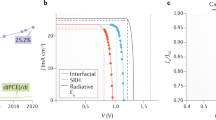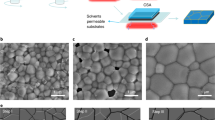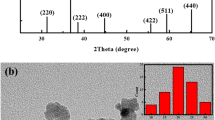Abstract
Despite the remarkable progress in power conversion efficiency of perovskite solar cells, going from individual small-size devices into large-area modules while preserving their commercial competitiveness compared with other thin-film solar cells remains a challenge. Major obstacles include reduction of both the resistive losses and intrinsic defects in the electron transport layers and the reliable fabrication of high-quality large-area perovskite films. Here we report a facile solvothermal method to synthesize single-crystalline TiO2 rhombohedral nanoparticles with exposed (001) facets. Owing to their low lattice mismatch and high affinity with the perovskite absorber, their high electron mobility and their lower density of defects, single-crystalline TiO2 nanoparticle-based small-size devices achieve an efficiency of 24.05% and a fill factor of 84.7%. The devices maintain about 90% of their initial performance after continuous operation for 1,400 h. We have fabricated large-area modules and obtained a certified efficiency of 22.72% with an active area of nearly 24 cm2, which represents the highest-efficiency modules with the lowest loss in efficiency when scaling up.
This is a preview of subscription content, access via your institution
Access options
Access Nature and 54 other Nature Portfolio journals
Get Nature+, our best-value online-access subscription
$29.99 / 30 days
cancel any time
Subscribe to this journal
Receive 12 print issues and online access
$259.00 per year
only $21.58 per issue
Buy this article
- Purchase on Springer Link
- Instant access to full article PDF
Prices may be subject to local taxes which are calculated during checkout





Similar content being viewed by others
Data availability
The data for this study are available from the corresponding authors upon reasonable request. Source data are provided with this paper.
Code availability
The finite-element method codes used in this work are available from the corresponding authors upon reasonable request.
References
Yoo, J. J. et al. Efficient perovskite solar cells via improved carrier management. Nature 590, 587–593 (2021).
Liu, Z. et al. A holistic approach to interface stabilization for efficient perovskite solar modules with over 2,000-hour operational stability. Nat. Energy 5, 596–604 (2020).
Park, B.-W. et al. Stabilization of formamidinium lead triiodide α-phase with isopropylammonium chloride for perovskite solar cells. Nat. Energy 6, 419–428 (2021).
Li, Z. et al. Scalable fabrication of perovskite solar cells. Nat. Rev. Mater. 3, 18017 (2018).
Werner, J. et al. Learning from existing photovoltaic technologies to identify alternative perovskite module designs. Energy Environ. Sci. 13, 3393–3403 (2020).
Lee, S. W., Bae, S., Kim, D. & Lee, H. S. Historical analysis of high-efficiency, large-area solar cells: toward upscaling of perovskite solar cells. Adv. Mater. 32, 2002202 (2020).
Peng, J. et al. Nanoscale localized contacts for high fill factors in polymer-passivated perovskite solar cells. Science 371, 390–395 (2021).
Stolterfoht, M. et al. Approaching the fill factor Shockley–Queisser limit in stable, dopant-free triple cation perovskite solar cells. Energy Environ. Sci. 10, 1530–1539 (2017).
Kim, D. H., Whitaker, J. B., Li, Z., van Hest, M. F. A. M. & Zhu, K. Outlook and challenges of perovskite solar cells toward terawatt-scale photovoltaic module technology. Joule 2, 1437–1451 (2018).
Jiang, Q. et al. Surface passivation of perovskite film for efficient solar cells. Nat. Photon. 13, 460–466 (2019).
Kim, M. et al. Enhanced electrical properties of Li-salts doped mesoporous TiO2 in perovskite solar cells. Joule 5, 659–672 (2021).
Kim, G. et al. Impact of strain relaxation on performance of α-formamidinium lead iodide perovskite solar cells. Science 370, 108–112 (2020).
Marchioro, A. et al. Unravelling the mechanism of photoinduced charge transfer processes in lead iodide perovskite solar cells. Nat. Photon. 8, 250–255 (2014).
Edri, E. et al. Why lead methylammonium tri-iodide perovskite-based solar cells require a mesoporous electron transporting scaffold (but not necessarily a hole conductor). Nano Lett. 14, 1000–1004 (2014).
Yang, Z. et al. Device physics of back-contact perovskite solar cells. Energy Environ. Sci. 13, 1753–1765 (2020).
Wang, Y., Yue, Y., Yang, X. & Han, L. Toward long-term stable and highly efficient perovskite solar cells via effective charge transporting materials. Adv. Energy Mater. 8, 1800249 (2018).
Shahvaranfard, F. et al. Engineering of the electron transport layer/perovskite interface in solar cells designed on TiO2 rutile nanorods. Adv. Funct. Mater. 30, 1909738 (2020).
Giordano, F. et al. Enhanced electronic properties in mesoporous TiO2 via lithium doping for high-efficiency perovskite solar cells. Nat. Commun. 7, 10379 (2016).
Zhou, H. et al. Interface engineering of highly efficient perovskite solar cells. Science 345, 542–546 (2014).
Peng, J. et al. Efficient indium-doped TiOx electron transport layers for high-performance perovskite solar cells and perovskite-silicon tandems. Adv. Energy Mater. 7, 1601768 (2017).
Chen, J., Tao, H. B. & Liu, B. Unraveling the intrinsic structures that influence the transport of charges in TiO2 electrodes. Adv. Energy Mater. 7, 1700886 (2017).
Tan, H. et al. Efficient and stable solution-processed planar perovskite solar cells via contact passivation. Science 355, 722–726 (2017).
Luo, J. et al. Surface rutilization of anatase TiO2 for efficient electron extraction and stable Pmax output of perovskite solar cells. Chem 4, 911–923 (2018).
Geng, W. et al. Structures and electronic properties of different CH3NH3PbI3/TiO2 interface: a first-principles study. Sci. Rep. 6, 20131 (2016).
Du, B. et al. Crystal face dependent charge carrier extraction in TiO2/perovskite heterojunctions. Nano Energy 67, 104227 (2020).
Maitani, M. M. et al. Effects of energetics with {001} facet-dominant anatase TiO2 scaffold on electron transport in CH3NH3PbI3 perovskite solar cells. Electrochim. Acta 300, 445–454 (2019).
Biccari, F. et al. Graphene-based electron transport layers in perovskite solar cells: a step-up for an efficient carrier collection. Adv. Energy Mater. 7, 1701349 (2017).
Noel, N. K. et al. Elucidating the role of a tetrafluoroborate-based ionic liquid at the n-type oxide/perovskite interface. Adv. Energy Mater. 10, 1903231 (2019).
Xiaobo, C. & Mao, S. S. Titanium dioxide nanomaterials: synthesis, properties, modifications, and applications. Chem. Rev. 107, 2891–2959 (2007).
Ding, Y. et al. Shape-controlled synthesis of single-crystalline anatase TiO2 micro/nanoarchitectures for efficient dye-sensitized solar cells. Sustain. Energy Fuels 1, 520–528 (2017).
Gloter, A., Ewels, C., Umek, P., Arcon, D. & Colliex, C. Electronic structure of titania-based nanotubes investigated by EELS spectroscopy. Phys. Rev. B 80, 035413 (2009).
Mosconi, E., Ronca, E. & De Angelis, F. First-principles investigation of the TiO2/organohalide perovskites interface: the role of interfacial chlorine. J. Phys. Chem. Lett. 5, 2619–2625 (2014).
Jiang, Q. et al. Enhanced electron extraction using SnO2 for high-efficiency planar-structure HC(NH2)2PbI3-based perovskite solar cells. Nat. Energy 2, 16177 (2016).
Klasen, A. et al. Removal of surface oxygen vacancies increases conductance through TiO2 thin films for perovskite solar cells. J. Phys. Chem. C 123, 13458–13466 (2019).
Gratia, P. et al. Intrinsic halide segregation at nanometer scale determines the high efficiency of mixed cation/mixed halide perovskite solar cells. J. Am. Chem. Soc. 138, 15821–15824 (2016).
Chen, P., Bai, Y. & Wang, L. Minimizing voltage losses in perovskite solar cells. Small Struct. 2, 2000050 (2020).
Shi, J. et al. Fluorinated low-dimensional Ruddlesden–Popper perovskite solar cells with over 17% power conversion efficiency and improved stability. Adv. Mater. 31, 1901673 (2019).
Le Corre, V. M., Sherkar, T. S., Koopmans, M. & Koster, L. J. A. Identification of the dominant recombination process for perovskite solar cells based on machine learning. Cell Rep. Phys. Sci. 2, 100346 (2021).
Pockett, A. & Carnie, M. J. Ionic influences on recombination in perovskite solar cells. ACS Energy Lett. 2, 1683–1689 (2017).
Park, N.-G. & Zhu, K. Scalable fabrication and coating methods for perovskite solar cells and solar modules. Nat. Rev. Mater. 5, 333–350 (2020).
Tress, W. Perovskite solar cells on the way to their radiative efficiency limit-insights into a success story of high open-circuit voltage and low recombination. Adv. Energy Mater. 7, 1602358 (2017).
Chen, J. & Park, N.-G. Materials and methods for interface engineering toward stable and efficient perovskite solar cells. ACS Energy Lett. 5, 2742–2786 (2020).
Yao, J. et al. Quantifying losses in open-circuit voltage in solution-processable solar cells. Phys. Rev. Appl. 4, 014020 (2015).
Stolterfoht, M. et al. Visualization and suppression of interfacial recombination for high-efficiency large-area pin perovskite solar cells. Nat. Energy 3, 847–854 (2018).
Min, H. et al. Perovskite solar cells with atomically coherent interlayers on SnO2 electrodes. Nature 598, 444–450 (2021).
Krogmeier, B., Staub, F., Grabowski, D., Rau, U. & Kirchartz, T. Quantitative analysis of the transient photoluminescence of CH3NH3PbI3/PC61BM heterojunctions by numerical simulations. Sustain. Energy Fuels 2, 1027–1034 (2018).
Gong, X. et al. Highly efficient perovskite solar cells with gradient bilayer electron transport materials. Nano Lett. 18, 3969–3977 (2018).
Lin, P. Y. et al. Simultaneously enhancing dissociation and suppressing recombination in perovskite solar cells. Nano Energy 36, 95–101 (2017).
Qiu, L., He, S., Ono, L. K., Liu, S. & Qi, Y. Scalable fabrication of metal halide perovskite solar cells and modules. ACS Energy Lett. 4, 2147–2167 (2019).
Ding, B. et al. Low-temperature SnO2-modified TiO2 yields record efficiency for normal planar perovskite solar modules. J. Mater. Chem. A 6, 10233–10242 (2018).
Leijtens, T. et al. Overcoming ultraviolet light instability of sensitized TiO2 with meso-superstructured organometal tri-halide perovskite solar cells. Nat. Commun. 4, 2885 (2013).
Boyd, C. C., Cheacharoen, R., Leijtens, T. & McGehee, M. D. Understanding degradation mechanisms and improving stability of perovskite photovoltaics. Chem. Rev. 119, 3418–3451 (2019).
Zhang, F. et al. Complexities of contact potential difference measurements on metal halide perovskite surfaces. J. Phys. Chem. Lett. 10, 890–896 (2019).
Acknowledgements
This work was supported by the National Key R&D Program of China (2018YFB1500101), the 111 Project (no. B16016) and the National Natural Science Foundation of China (no. U1705256 and no. 51961165106). V.D. and P.D. acknowledge the financial support by the Deutsche Forschungsgemeinschaft in the frame of the Priority Program SPP 2196 (project DY 18/14–1). We thank the Swiss National Science Foundation for financial support of the SOLAR4D project (project no. 200020L_1729/1) and Luxembourg Fonds National de la Recherche (‘SUNSPOT’, no. 11244141 and INTER, no. 16/11534230).
Author information
Authors and Affiliations
Contributions
Y.D. and B.D. conceived and made the experiment. Y.D. synthesized the single-crystalline TiO2 nanoparticles. H.K. performed the XPS, UPS and SEM characterization. O.J.U. conducted the HIM-SIMS characterization with supervision from J.-N.A. T.G. performed the UHV-AFM and KPFM measurement with supervision from A.R. Z.Y. and J.S. simulated the influence of trap state density and electron mobility of TiO2 on the whole photovoltaic performance. Y.L. conducted the UPS, Hall effect measurement and spherical aberration electron microscopy with supervision from G.Y. H.H. performed the steady-state, transient absorption spectroscopy and transient absorption spectroscopy measurement with supervision from W.D. C.L., Y.Y. and X.Z. conducted SCLC and C–V measurements. M.A. and P.D. made the time-resolved microwave conductivity measurements. V.S. performed OCVD measurements with supervision from V.D. R.W. performed the TRPL characterization. Y.D. and B.D. wrote the first draft of the manuscript, and all authors contributed feedback and comments. G.Y., J.W. S.D., P.J.D. and M.K.N. directed and supervised the research.
Corresponding authors
Ethics declarations
Competing interests
The authors declare no competing interests.
Peer review
Peer review information
Nature Nanotechnology thanks the anonymous reviewers for their contribution to the peer review of this work.
Additional information
Publisher’s note Springer Nature remains neutral with regard to jurisdictional claims in published maps and institutional affiliations.
Supplementary information
Supplementary Information
Supplementary Notes 1–4, Figs. 1–34, Tables 1–8, experimental details and refs. 1–82.
Supplementary Video 1
Water immersion test.
Source data
Source Data Fig. 1
Simulation data.
Source Data Fig. 2
Unprocessed EELS data.
Source Data Fig. 3
Unprocessed J–V data, EQE data and so on.
Source Data Fig. 4
Unprocessed time-resolved photoluminescence and transient absorption spectra data.
Source Data Fig. 5
Unprocessed J–V and EQE data, and statistical source data.
Rights and permissions
About this article
Cite this article
Ding, Y., Ding, B., Kanda, H. et al. Single-crystalline TiO2 nanoparticles for stable and efficient perovskite modules. Nat. Nanotechnol. 17, 598–605 (2022). https://doi.org/10.1038/s41565-022-01108-1
Received:
Accepted:
Published:
Issue Date:
DOI: https://doi.org/10.1038/s41565-022-01108-1
This article is cited by
-
Multifunctional sulfonium-based treatment for perovskite solar cells with less than 1% efficiency loss over 4,500-h operational stability tests
Nature Energy (2024)
-
Iodide manipulation using zinc additives for efficient perovskite solar minimodules
Nature Communications (2024)
-
A thermotropic liquid crystal enables efficient and stable perovskite solar modules
Nature Energy (2024)
-
Highlights of mainstream solar cell efficiencies in 2023
Frontiers in Energy (2024)
-
Stabilization of photoactive phases for perovskite photovoltaics
Nature Reviews Chemistry (2023)



